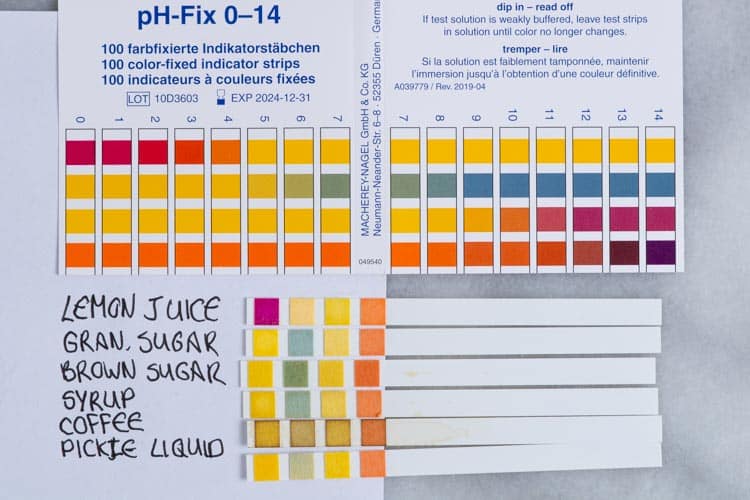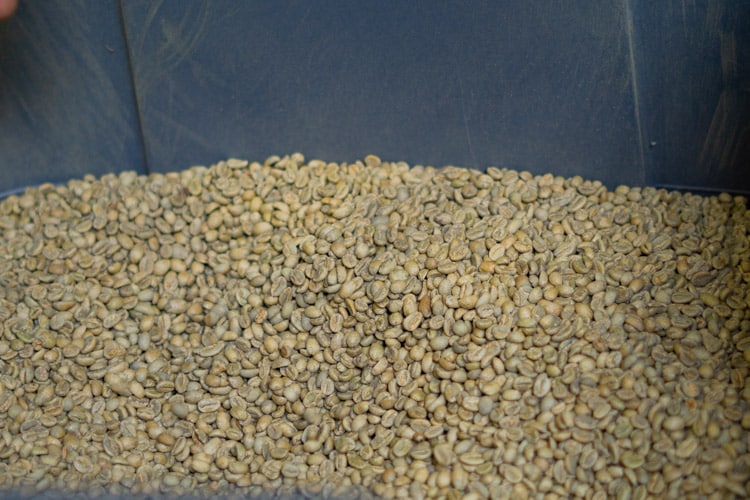Learn the science behind:

Introduction to the pH of Coffee: Is Coffee an Acid or a Base?
Being one of the most popular beverages in the world, coffee is always under the microscope for its many known and unknown aspects. Speaking of which, we’ll address one of the most commonly asked scientific coffee question — whether coffee is acidic or basic.
Coffee’s pH reading tells us that coffee is an acidic beverage. Because on the pH scale, coffee ranges from about 4.85–5.1. Anything that falls below a value of 7 is considered acidic.
So, let’s see why and how coffee is acidic without triggering the awful flashbacks of junior high chemistry classes.
This is a guest post by Saleheen from Coffee A to Z. CoffeeAtoZ shares coffee-related information like – brewing methods, recipes, comparisons, reviews, etc.
Is Coffee An Acid Or A Base? – pH Scale Decides
The pH level of a substance determines whether it is acidic or basic. The pH scale ranges from 0 to 14. The middle value, 7, is considered a neutral value. Bases are alkaline elements and have a pH value in the range of 7.0–14. Acids, on the other hand, have a pH value of less than 7. The further away from neutral, the more acidic, are alkaline a substance is.
As we mentioned, on the pH scale, coffee ranges from 4.85 to 5.10, making it an acidic substance. Coffee contains a lot of acidic compounds, such as chlorogenic acid, polyphenols, and tannins.
Keep in mind that regular lemonades have a 2–3 pH reading, orange juice has a 3.3–4.2 pH range, apple juice has a pH of around 3.8, and carbonated sodas can have a pH level as low as 2.5. So, compared to other popular daily drinks, coffee is closer to being a base than you think.
Now that we’ve explained the nature of coffee, it’s time to get into the chemistry behind its acidic nature.

Nailing Down The Chemistry Behind Coffee Acidity
Coffee contains 2 types of acids: organic acids and chlorogenic acid. The main organic acids in coffee are citric, quinic, malic, tartaric, and acetic acids. Each of these acids brings its own aspect of flavor to the cup. In short, these acids not only contribute to coffee’s acidity, but also add a lot of flavor and taste.
Organic Acids
- Citric Acid – The acid that brings out the orange-like sensation on our palate. Coffees with citric acid have that trademark citrusy flavor note.
- Quinic Acid – A vital acid in coffee. It enables better antioxidant effects in coffee as well as offers anti-neuroinflammatory properties. Chlorogenic acids in coffee degrade and form quinic acids when roasted. It brings astringency to coffee and causes a sour-like sensation in our stomachs. Note that dark-roasted coffees are high in quinic acid.
- Malic Acid – This acid is responsible for providing the “lively” flavor notes in coffee. It’s almost like biting into a juicy green apple. Coffee with a good amount of malic acid tends to develop a green apple-like, subtle liveliness.
- Tartaric Acid – It imparts a red wine-like flavor to coffee. A grape-like acidity that’s easily distinguishable from other acids. It is a rarer note than the others.
- Acetic Acid – The most familiar one of the bunch. Acetic acid brings a vinegarish type of mouthfeel that is unpleasant and something you shouldn’t look for in your coffee abundantly.
Chlorogenic Acid
This acid is something that’s present as a whole molecule in green coffee beans. It also happens to be an antioxidant. As mentioned in the quinic acid section, during the roasting process, it breaks down and turns into quinic and caffeic acids.
This degradation of chlorogenic acid alters the concentration of overall acidic content. The extent of this degradation and alteration depends on various factors.
In fact, the darker the roast level is, the lower the level of chlorogenic acid you’ll have. This is why lighter roasted coffees have a more pronounced acidity in their flavor profile.
When coffee beans are in their green state, they have a large concentration of chlorogenic acid. Different varieties may also contain different concentrations. For instance, Arabica beans tend to have a lower concentration of chlorogenic acid than Robusta beans.

Reasons For Coffee’s Acidity
As the coffee cherries develop on the trees, the citric and malic acids begin to form inside the beans. Later, they impart a tart or acidic flavor to coffee, similar to lemon or a green apple-like liveliness.
Coffee plants that are shade-grown in high altitudes are more acidic. Because shade-grown high-altitude cherries are grown with minimal stress and can gather higher levels of organic acids, caffeine, and sugar.
The final levels of sucrose, fructose, chlorogenic acid, and other organic acids depend on the species. For example, Robusta has twice as many chlorogenic acids as other coffee plants.
Coffee processes such as cleaning, drying, roasting, and grinding all affect the level of acidity of the beans. Naturally processed beans are less acidic than washed beans. It’s because the washing phase takes away the fructose and sucrose from the coffee, which would normally ‘hide’ the acidity, much like they do in sodas. Roasting coffee beans breaks down organic acids. The longer beans are roasted, the less acidic they become.
Lastly, brewing makes an impact. Brewing at higher temperatures will result in the presence of a higher concentration of acids (see table 2). It’s one of the reasons why cold brew coffee tastes different from ones made at high(er) temperatures. If you let brewed coffee sit for a few hours, it’ll turn more acidic. With time, more compounds can dilute into the water, which increases the level of acidity.

The Quandary: Acidic Coffee Has Alkaloid Caffeine
So, we’ve finally reached an interesting juncture in our coffee chemistry discussion. But before talking about caffeine and its role in coffee, let’s understand the alkaloid.
The term “alkaloid” means literally “alkali-like”. Alkaloid is commonly used to describe basic substances. It’s a nitrogen-containing compound found in plants. Alkaloids have complex molecular structures, and over 2000 alkaloids are known today. Some renowned alkaloids are morphine, reserpine, lupanine, codeine, quinine, atropine, and, of course, caffeine.
Now, let’s talk about caffeine and why its presence does not affect coffee’s true acidic nature. Caffeine is a bitter, white, powdered, water-soluble alkaloid.
Caffeine, an alkaloid, is in fact a pretty weak base. So caffeine has no chance of affecting the overall pH of coffee in the first place. Also, caffeine isn’t even a major component as it only accounts for less than 1% of the dry mass.
Remember that coffee contains hundreds, if not thousands, of other compounds, including caffeine. And here’s the most important part: among these other compounds, the majority are organic and chlorogenic acids. As such, the (strong) acids outnumber the (weak) base, see table 1 and 2.
| Coffee | Caffeine Content (mg/l) |
|---|---|
| Instant Decaf Coffee | 8.5 – 13 |
| Brewed Decaf Coffee | 13 – 17 |
| Instant Coffee | 275 – 425 |
| Espresso (2 oz.) | 425 |
| Brewed Coffee | 340 – 575 |
| Drip Coffee | 485 – 740 |
| Acids | 70°C (158°F) | 94°C (201°F) | 100°C (212°F) |
|---|---|---|---|
| Malic Acid | 131 | 137 | 122 |
| Acetic Acid | 151 | 226 | 187 |
| Quinic Acid | 348 | 495 | 383 |
| Citric Acid | 388 | 461 | 332 |
| Chlorogenic Acids | 873 | 1064 | 1068 |
Note: Results were taken after cups of coffee were brewed for 5 minutes using only fine ground coffee. The measure of concentration by weight unit used here is mg/L.
Final Words
In conclusion, coffee is a weakly acidic beverage with a pH-value of approximately 5. The composition of coffee is very complex, having both acidic and alkaline components. And coffee remains acidic even with the presence of caffeine, an alkaloid.
The acidity is crucial to coffee’s flavor and taste. So much so, that when acidic compounds are found to be lacking, coffee tastes flat. You can influence the acidity by adjusting roasting and brewing processes. But that’s not all. The acidity of coffee that we finally get to taste is a result of numerous natural and human-controlled variables in its lifecycle.
This is a guest post by Saleheen from Coffee A to Z. CoffeeAtoZ shares coffee-related information like – brewing methods, recipes, comparisons, reviews, etc.
Sources
- Caffeine Content Of Popular Drinks. The University of Utah. Link.
- Book: Sensory Evaluation of Coffee: Technical Unit Quality Series. No 9. International Coffee Organization. 1991. 209-243.
- pH – Wikipedia. Link.
- The Chemistry of Organic Acids in Coffee. Link.
- Acids in Coffee: A Review of Sensory Measurements and Meta-Analysis of Chemical Composition. Link.
- The Perspective Of Caffeine And Caffeine Derived Compounds In Therapy. Miroslav Pohanka.
What's your challenge?
Struggling with your food product or production process? Not sure where to start and what to do? Or are you struggling to find and maintain the right expertise and knowledge in your food business?
That's where I might be able to help. Fill out a quick form to request a 30 minute discovery call so we can discuss your challenges. By the end, you'll know if, and how I might be able to help.




